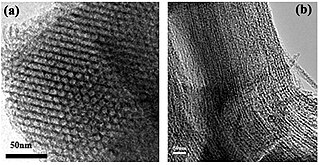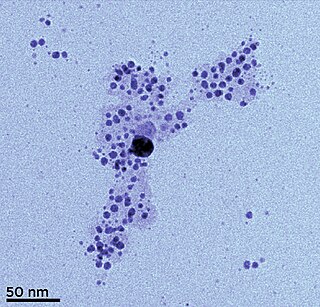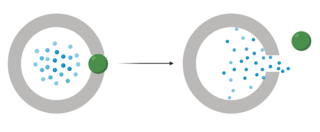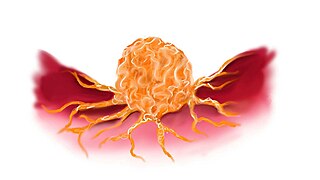Related Research Articles

Nanomaterials describe, in principle, materials of which a single unit is sized between 1 and 100 nm.

A molecular machine, nanite, or nanomachine is a molecular component that produces quasi-mechanical movements (output) in response to specific stimuli (input). In cellular biology, macromolecular machines frequently perform tasks essential for life, such as DNA replication and ATP synthesis. The expression is often more generally applied to molecules that simply mimic functions that occur at the macroscopic level. The term is also common in nanotechnology where a number of highly complex molecular machines have been proposed that are aimed at the goal of constructing a molecular assembler.

A mesoporous material is a nanoporous material containing pores with diameters between 2 and 50 nm, according to IUPAC nomenclature. For comparison, IUPAC defines microporous material as a material having pores smaller than 2 nm in diameter and macroporous material as a material having pores larger than 50 nm in diameter.

Cetrimonium bromide ([(C16H33)N(CH3)3]Br; cetyltrimethylammonium bromide; hexadecyltrimethylammonium bromide; CTAB) is a quaternary ammonium surfactant.
Gold Nanocages are hollow, porous gold nanoparticles ranging in size from 10 to over 150 nm. They are created by reacting silver nanoparticles with chloroauric acid (HAuCl4) in boiling water. Whereas gold nanoparticles absorb light in the visible spectrum of light (at about 550 nm), gold nanocages absorb light in the near-infrared, where biological tissues absorb the least light. Because they are also biocompatible, gold nanocages are promising as a contrast agent for optical coherence tomography. Gold nanocages also absorb light and heat up (Photothermal effect), killing surrounding cancer cells. Nanocages have been functionalized with cancer-specific antibodies.
Nanochemistry is the combination of chemistry and nano science. Nanochemistry is associated with synthesis of building blocks which are dependent on size, surface, shape and defect properties. Nanochemistry is being used in chemical, materials and physical, science as well as engineering, biological and medical applications. Nanochemistry and other nanoscience fields have the same core concepts but the usages of those concepts are different.
As the world's energy demand continues to grow, the development of more efficient and sustainable technologies for generating and storing energy is becoming increasingly important. According to Dr. Wade Adams from Rice University, energy will be the most pressing problem facing humanity in the next 50 years and nanotechnology has potential to solve this issue. Nanotechnology, a relatively new field of science and engineering, has shown promise to have a significant impact on the energy industry. Nanotechnology is defined as any technology that contains particles with one dimension under 100 nanometers in length. For scale, a single virus particle is about 100 nanometers wide.

Mesoporous silica is a form of silica that is characterised by its mesoporous structure, that is, having pores that range from 2 nm to 50 nm in diameter. According to IUPAC's terminology, mesoporosity sits between microporous (<2 nm) and macroporous (>50 nm). Mesoporous silica is a relatively recent development in nanotechnology. The most common types of mesoporous nanoparticles are MCM-41 and SBA-15. Research continues on the particles, which have applications in catalysis, drug delivery and imaging. Mesoporous ordered silica films have been also obtained with different pore topologies.

An artificial enzyme is a synthetic organic molecule or ion that recreates one or more functions of an enzyme. It seeks to deliver catalysis at rates and selectivity observed in naturally occurring enzymes.

Silver nanoparticles are nanoparticles of silver of between 1 nm and 100 nm in size. While frequently described as being 'silver' some are composed of a large percentage of silver oxide due to their large ratio of surface to bulk silver atoms. Numerous shapes of nanoparticles can be constructed depending on the application at hand. Commonly used silver nanoparticles are spherical, but diamond, octagonal, and thin sheets are also common.

Younan Xia is a Chinese-American chemist, materials scientist, and bioengineer. He is the Brock Family Chair and Georgia Research Alliance (GRA) Eminent Scholar in Nanomedicine in the Wallace H. Coulter Department of Biomedical Engineering, with joint appointments in the School of Chemistry & Biochemistry, the School of Chemical & Biomolecular Engineering, and Parker H. Petit Institute for Bioengineering & Bioscience at the Georgia Institute of Technology.
Mesoporous organosilica are a type of silica containing organic groups that give rise to mesoporosity. They exhibit pore size ranging from 2 nm - 50 nm, depending on the organic substituents. In contrast, zeolites exhibit pore sizes less than a nanometer. PMOs have potential applications as catalysts, adsorbents, trapping agents, drug delivery agents, stationary phases in chromatography and chemical sensors.

A localized surface plasmon (LSP) is the result of the confinement of a surface plasmon in a nanoparticle of size comparable to or smaller than the wavelength of light used to excite the plasmon. When a small spherical metallic nanoparticle is irradiated by light, the oscillating electric field causes the conduction electrons to oscillate coherently. When the electron cloud is displaced relative to its original position, a restoring force arises from Coulombic attraction between electrons and nuclei. This force causes the electron cloud to oscillate. The oscillation frequency is determined by the density of electrons, the effective electron mass, and the size and shape of the charge distribution. The LSP has two important effects: electric fields near the particle's surface are greatly enhanced and the particle's optical absorption has a maximum at the plasmon resonant frequency. Surface plasmon resonance can also be tuned based on the shape of the nanoparticle. The plasmon frequency can be related to the metal dielectric constant. The enhancement falls off quickly with distance from the surface and, for noble metal nanoparticles, the resonance occurs at visible wavelengths. Localized surface plasmon resonance creates brilliant colors in metal colloidal solutions.

Organic photonics includes the generation, emission, transmission, modulation, signal processing, switching, amplification, and detection/sensing of light, using organic optical materials.

Carbon quantum dots also commonly called Carbon dots are carbon nanoparticles which are less than 10 nm in size and have some form of surface passivation.
Susan M. Kauzlarich is an American chemist and is presently a distinguished professor of Chemistry at the University of California, Davis. At UC Davis, Kauzlarich leads a research group focused on the synthesis and characterization of Zintl phases and nanoclusters with applications in the fields of thermoelectric materials, magnetic resonance imaging, energy storage, opto-electronics, and drug delivery. Kauzlarich has published over 250 peer-reviewed publications and has been awarded several patents. In 2009, Kauzlarich received the annual Presidential Award for Excellence in Science, Mathematics and Engineering Mentoring, which is administered by the National Science Foundation to acknowledge faculty members who raise the membership of minorities, women and disabled students in the science and engineering fields. In January 2022 she became Deputy Editor for the scientific journal, Science Advances.
So-Jung Park 박소정(朴昭靜) is a Professor of Chemistry at Ewha Womans University, Republic of Korea. Her research considers the self-assembly of nanoparticles and functional molecules for biomedical and optoelectronic devices. She serves as Associate Editor of ACS Applied Materials & Interfaces and Nanoscale.
Steven L. Suib is an American inorganic chemist, academic and researcher. He is a Board of Trustees Distinguished Professor of Chemistry at University of Connecticut. He is a director of the Institute of Materials Science and of the Center for Advanced Microscopy and Materials Analysis.

Gated drug delivery systems are a method of controlled drug release that center around the use of physical molecules that cover the pores of drug carriers until triggered for removal by an external stimulus. Gated drug delivery systems are a recent innovation in the field of drug delivery and pose as a promising candidate for future drug delivery systems that are effective at targeting certain sites without having leakages or off target effects in normal tissues. This new technology has the potential to be used in a variety of tissues over a wide range of disease states and has the added benefit of protecting healthy tissues and reducing systemic side effects.

Reduction-sensitive nanoparticles (RSNP) consist of nanocarriers that are chemically responsive to reduction. Drug delivery systems using RSNP can be loaded with different drugs that are designed to be released within a concentrated reducing environment, such as the tumor-targeted microenvironment. Reduction-Sensitive Nanoparticles provide an efficient method of targeted drug delivery for the improved controlled release of medication within localized areas of the body.
References
- 1 2 "Jeffrey Zink". ucla.edu. Retrieved November 18, 2017.
- ↑ "Lab Group". ucla.edu. Retrieved November 18, 2017.
- ↑ "Jeffrey Zink". ucla.edu. Retrieved November 18, 2017.
- ↑ "Former UCLA professor wins Nobel Prize for foundational chemistry work". dailybruin.com. October 13, 2016. Retrieved November 18, 2017.